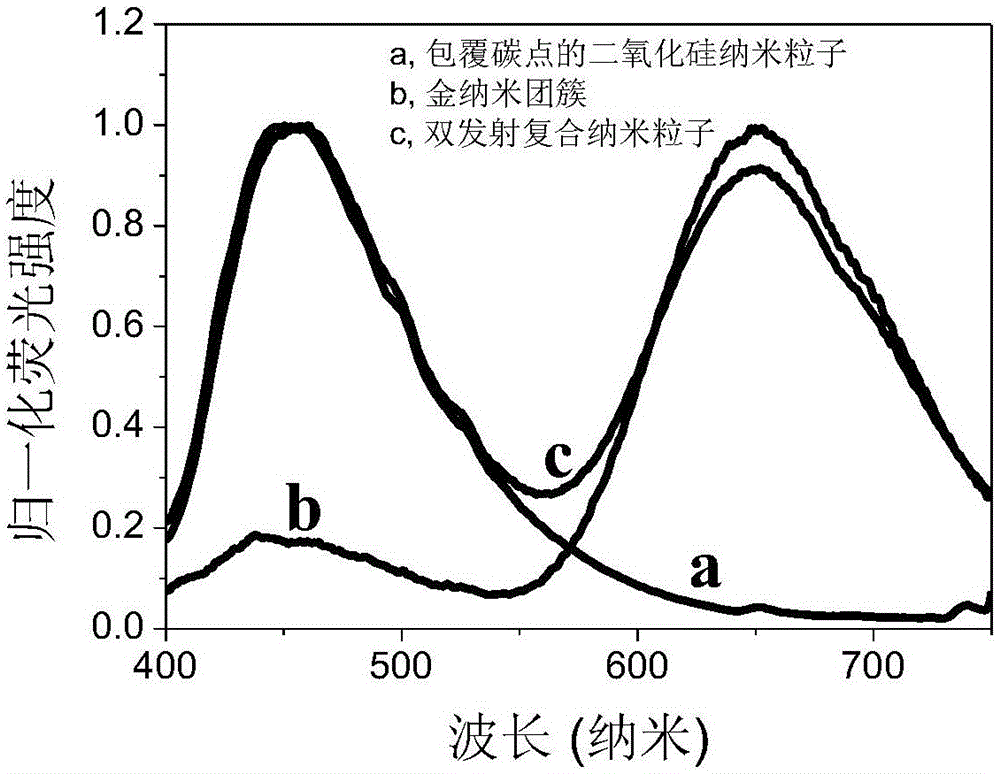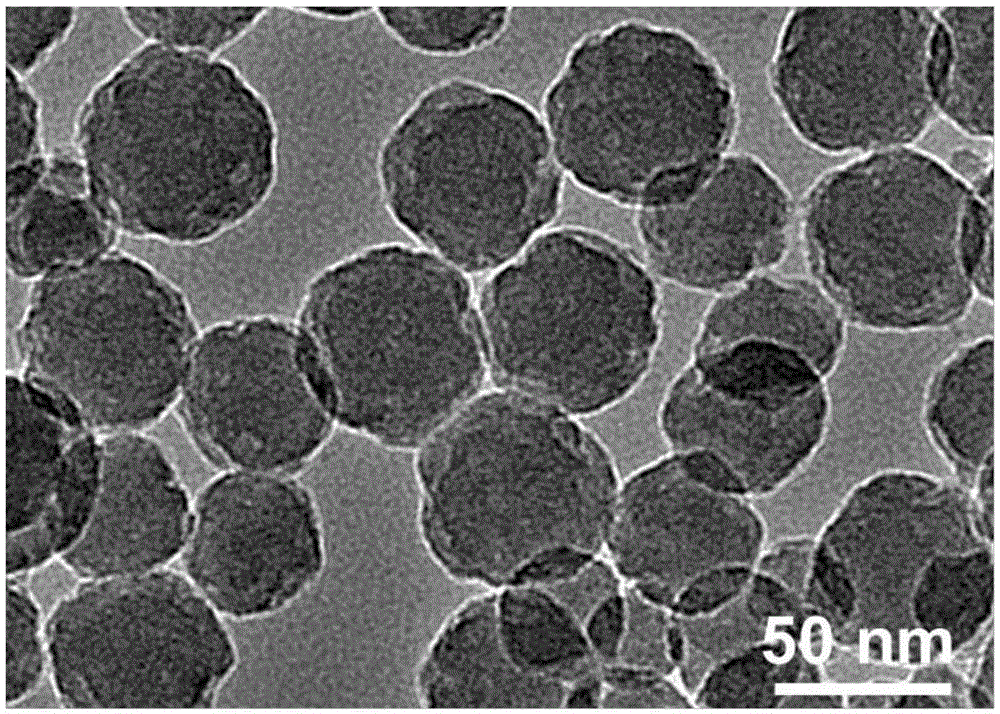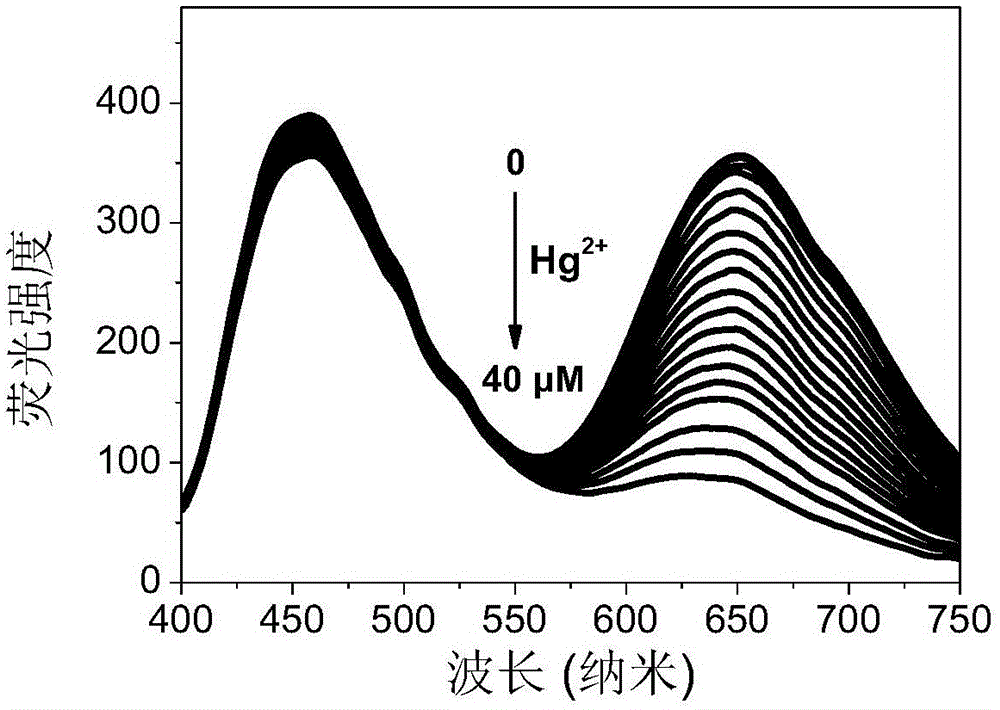Dual emission rate type fluorescent probe for visually detecting carbon dots-Au nanoclusters of mercury ions and preparation method
A technology of gold nanoclusters and fluorescent probes, applied in chemical instruments and methods, luminescent materials, fluorescence/phosphorescence, etc., can solve the problems of complex synthesis and modification process, poor water solubility and photostability, and low quantum yield
- Summary
- Abstract
- Description
- Claims
- Application Information
AI Technical Summary
Problems solved by technology
Method used
Image
Examples
Embodiment 1
[0026] (1) Preparation of aminated fluorescent silica nanoparticles coated with carbon dots
[0027] The siloxane functionalized carbon dots are prepared by adopting the method of the published Chinese patent (publication number: CN103421495A); other preparation methods are not limited.
[0028] In this experiment, silica nanoparticles coated with carbon dots were prepared by inverse microemulsion method. The specific experimental steps are as follows: add 7.7mL cyclohexane, 1.77mL Triton X-100 and 1.77mL n-hexanol to a 25mL round bottom flask respectively, then add 380μL water, and stir the system vigorously for about 10min to form a stable and uniform After the inverse microemulsion system is formed, add 50 μL tetraethyl orthosilicate to the flask, stir evenly, add 25 μL new carbon quantum dots and 200 μL ammonia water (25wt%) to it, and place the reaction system React at room temperature; after reacting for 18 hours, add isopropanol three times the volume of the reaction s...
Embodiment 2
[0036] (1) Preparation of aminated fluorescent silica nanoparticles coated with carbon dots
[0037] Siloxane functionalized carbon dots were prepared by adopting the method of the published Chinese patent (publication number: CN103421495A).
[0038] In this experiment, silica nanoparticles coated with carbon dots were prepared by inverse microemulsion method. The specific experimental steps are as follows: add 7.7mL cyclohexane, 1.77mL Triton X-100 and 1.77mL n-hexanol to a 25mL round bottom flask respectively, then add 380μL water, and stir the system vigorously for about 10min to form a stable and uniform After the inverse microemulsion system is formed, add 50 μL tetraethyl orthosilicate to the flask, stir evenly, add 25 μL new carbon quantum dots and 200 μL ammonia water (25wt%) to it, and place the reaction system React at room temperature; after reacting for 20 hours, add isopropanol three times the volume of the reaction solution to the reaction system to break the em...
Embodiment 3
[0046] (1) Preparation of aminated fluorescent silica nanoparticles coated with carbon dots
[0047] Siloxane functionalized carbon dots were prepared by adopting the method of the published Chinese patent (publication number: CN103421495A).
[0048] In this experiment, silica nanoparticles coated with carbon dots were prepared by inverse microemulsion method. The specific experimental steps are as follows: add 7.7mL cyclohexane, 1.77mL Triton X-100 and 1.77mL n-hexanol to a 25mL round bottom flask respectively, then add 380μL water, and stir the system vigorously for about 10min to form a stable and uniform After the inverse microemulsion system is formed, add 50 μL tetraethyl orthosilicate to the flask, stir evenly, add 25 μL new carbon quantum dots and 200 μL ammonia water (25wt%) to it, and place the reaction system React at room temperature; after reacting for 24 hours, add isopropanol three times the volume of the reaction solution to the reaction system to break the em...
PUM
 Login to View More
Login to View More Abstract
Description
Claims
Application Information
 Login to View More
Login to View More - R&D
- Intellectual Property
- Life Sciences
- Materials
- Tech Scout
- Unparalleled Data Quality
- Higher Quality Content
- 60% Fewer Hallucinations
Browse by: Latest US Patents, China's latest patents, Technical Efficacy Thesaurus, Application Domain, Technology Topic, Popular Technical Reports.
© 2025 PatSnap. All rights reserved.Legal|Privacy policy|Modern Slavery Act Transparency Statement|Sitemap|About US| Contact US: help@patsnap.com



